
Matrix Theory -Matrix Inversion School of Mathematical Sciences Teaching Group Main Reference books Fuzhen Zhang.Matrix Theory-Basic Results and Techniques,Second Edition. Springer,2011. llse C.F.Ipsen,Numerical Matrix Analysis:Linear Systems and Least Squares. S1AM,2009. Reference books: o Roger A.Horn and Charles A.Johnson:Matrix Analysis.Cambridge University Press,1985. Gene H.Golub and Charles F.Van Loan:Matrix Computations,Third Edition. Johns Hopkins Press,1996. Nicholas J.Higham.Accuracy and Stability of Numerical Algorithms,Second Edition.SIAM,2002. Y.Saad.Iterative Methods for Sparse Linear Systems,Second Edition.SIAM, Philadelphia,2003. Matrix Theory Inverse Maintained by Yan-Fei Jing
: Main Reference books Fuzhen Zhang. Matrix Theory-Basic Results and Techniques, Second Edition. Springer, 2011. Ilse C. F. Ipsen, Numerical Matrix Analysis: Linear Systems and Least Squares. SIAM, 2009. Reference books: Roger A. Horn and Charles A. Johnson: Matrix Analysis. Cambridge University Press, 1985. Gene H. Golub and Charles F. Van Loan: Matrix Computations, Third Edition. Johns Hopkins Press, 1996. Nicholas J. Higham. Accuracy and Stability of Numerical Algorithms, Second Edition. SIAM, 2002. Y. Saad. Iterative Methods for Sparse Linear Systems, Second Edition. SIAM, Philadelphia, 2003. Maintained by Yan-Fei Jing Matrix Theory ––Matrix Inversion School of Mathematical Sciences Teaching Group Matrix Theory Inverse
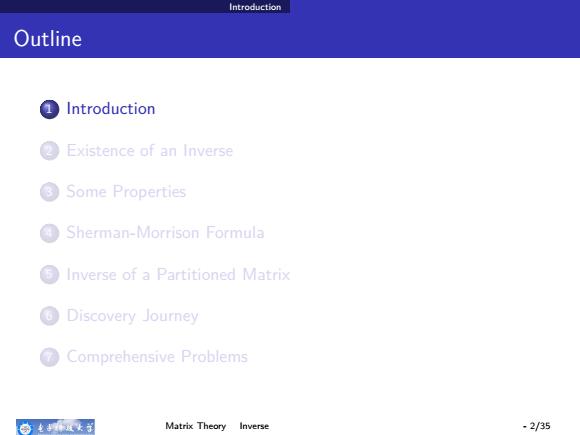
Introduction Outline Introduction Existence of an Inverse ③Some Properties Sherman-Morrison Formula Inverse of a Partitioned Matrix Discovery Journey Comprehensive Problems 争老年这大习 Matrix Theory Inverse -2/35
Introduction Outline 1 Introduction 2 Existence of an Inverse 3 Some Properties 4 Sherman-Morrison Formula 5 Inverse of a Partitioned Matrix 6 Discovery Journey 7 Comprehensive Problems Matrix Theory Inverse - 2/35
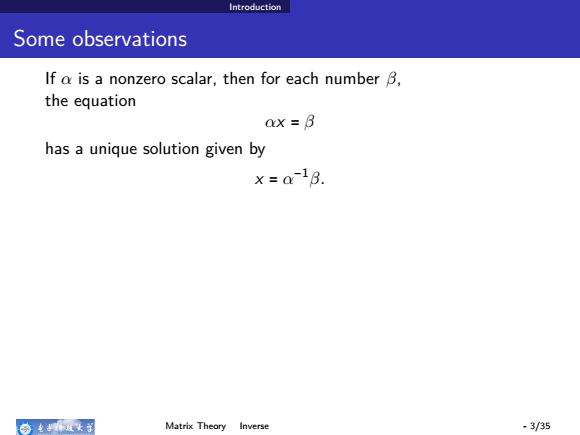
Introduction Some observations If a is a nonzero scalar,then for each number B, the equation ax=B has a unique solution given by x=a1B. 奇电有这头 Matrix Theory Inverse -3/35
Introduction Some observations If α is a nonzero scalar, then for each number β, the equation αx = β has a unique solution given by x = α −1 β. To prove that α −1β is a solution, write α(α −1 β) = (αα −1 )β = (1)β = β. Uniqueness follows because if x1 and x2 are two solutions, then αx1 = β = αx2 ⇒ α −1 (αx1) = α −1 (αx2) ⇒ (α −1α)x1 = (α −1α)x2 ⇒ (1)x1 = (1)x2 ⇒ x1 = x2. Matrix Theory Inverse - 3/35
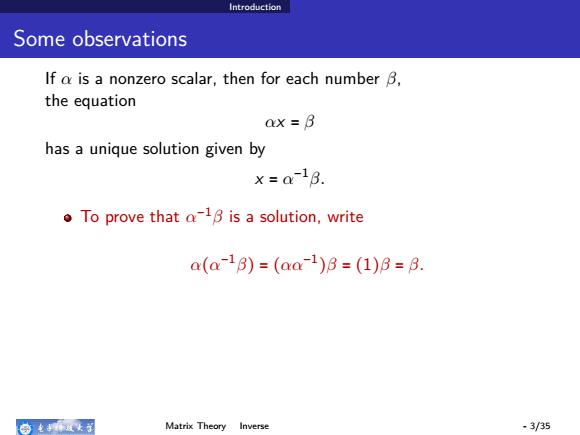
Introduction Some observations If a is a nonzero scalar,then for each number B, the equation aX=B has a unique solution given by x=a1B. o To prove that a-13 is a solution,write a(a-13)=(aa-1)3=(1)B=3. 奇电有这头 Matrix Theory Inverse -3/35
Introduction Some observations If α is a nonzero scalar, then for each number β, the equation αx = β has a unique solution given by x = α −1 β. To prove that α −1β is a solution, write α(α −1 β) = (αα−1 )β = (1)β = β. Uniqueness follows because if x1 and x2 are two solutions, then αx1 = β = αx2 ⇒ α −1 (αx1) = α −1 (αx2) ⇒ (α −1α)x1 = (α −1α)x2 ⇒ (1)x1 = (1)x2 ⇒ x1 = x2. Matrix Theory Inverse - 3/35
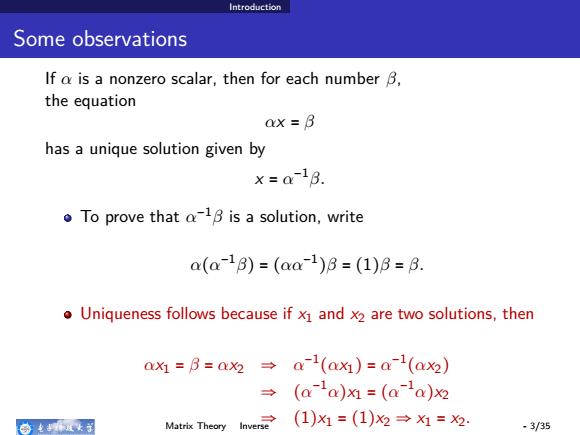
Introduction Some observations If a is a nonzero scalar,then for each number B, the equation aX=B has a unique solution given by x=a1B. To prove that a-13 is a solution,write a(a-13)=(aa-1)3=(1)B=3. o Uniqueness follows because if x1 and x2 are two solutions,then ax=B=a为→a-1(ax)=a-1(ax2) →(a1a)x=(a1a)x9 奇电有这女了 Matrix Theory (1)X1=(1)x9→xM=2: .3/35
Introduction Some observations If α is a nonzero scalar, then for each number β, the equation αx = β has a unique solution given by x = α −1 β. To prove that α −1β is a solution, write α(α −1 β) = (αα−1 )β = (1)β = β. Uniqueness follows because if x1 and x2 are two solutions, then αx1 = β = αx2 ⇒ α −1 (αx1) = α −1 (αx2) ⇒ (α −1α)x1 = (α −1α)x2 ⇒ (1)x1 = (1)x2 ⇒ x1 = x2. Matrix Theory Inverse - 3/35

Introduction Some remarks These observations seem pedantic,but they are important in order to see how to make the transition from scalar equations to matrix equations. 色电这女了 Matrix Theory Inverse -4/35
Introduction Some remarks These observations seem pedantic, but they are important in order to see how to make the transition from scalar equations to matrix equations. In particular, these arguments show that in addition to associativity, the properties αα −1 = 1 and α −1α = 1 (1) are the key ingredients. So if we want to solve matrix equations in the same fashion as we solve scalar equations, then a matrix analogue of (1) is needed. Matrix Theory Inverse - 4/35
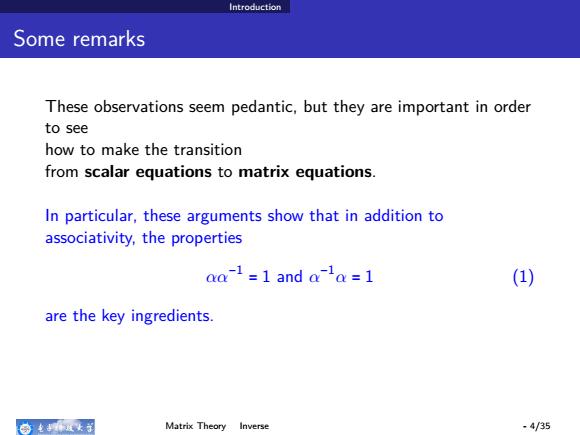
Introduction Some remarks These observations seem pedantic,but they are important in order to see how to make the transition from scalar equations to matrix equations. In particular,these arguments show that in addition to associativity,the properties aa-1=1 and a la=1 (1) are the key ingredients. 色电有这大习 Matrix Theory Inverse -4/35
Introduction Some remarks These observations seem pedantic, but they are important in order to see how to make the transition from scalar equations to matrix equations. In particular, these arguments show that in addition to associativity, the properties αα−1 = 1 and α −1α = 1 (1) are the key ingredients. So if we want to solve matrix equations in the same fashion as we solve scalar equations, then a matrix analogue of (1) is needed. Matrix Theory Inverse - 4/35
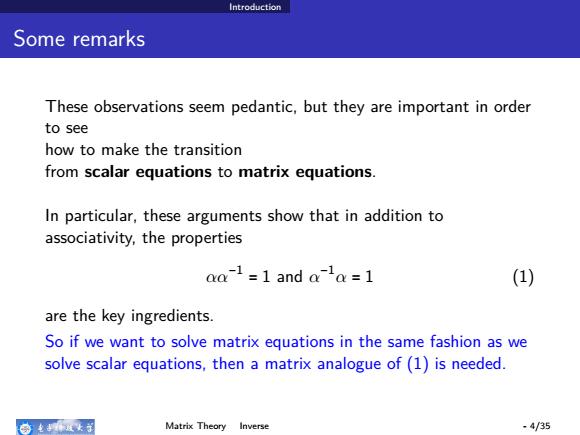
Introduction Some remarks These observations seem pedantic,but they are important in order to see how to make the transition from scalar equations to matrix equations. In particular,these arguments show that in addition to associativity,the properties aa1=1 and aa=1 (1) are the key ingredients. So if we want to solve matrix equations in the same fashion as we solve scalar equations,then a matrix analogue of(1)is needed. 争老年这大习 Matrix Theory Inverse -4/35
Introduction Some remarks These observations seem pedantic, but they are important in order to see how to make the transition from scalar equations to matrix equations. In particular, these arguments show that in addition to associativity, the properties αα−1 = 1 and α −1α = 1 (1) are the key ingredients. So if we want to solve matrix equations in the same fashion as we solve scalar equations, then a matrix analogue of (1) is needed. Matrix Theory Inverse - 4/35
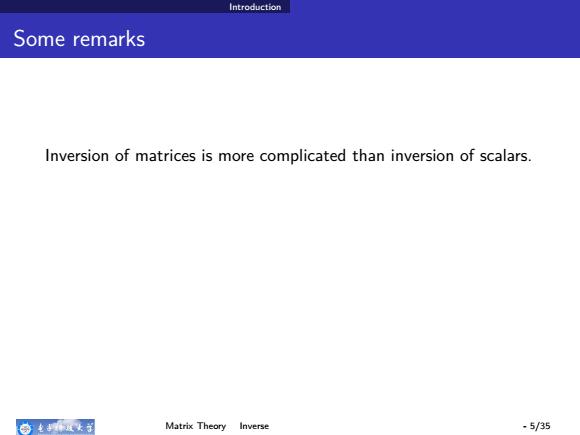
Introduction Some remarks Inversion of matrices is more complicated than inversion of scalars. 务老环这女子 Matrix Theory Inverse -5/35
Introduction Some remarks Inversion of matrices is more complicated than inversion of scalars. There is only one scalar that does not have an inverse : 0. There are many matrices without inverses. How to determine an inverse with respect to matrix multiplication? Matrix Theory Inverse - 5/35
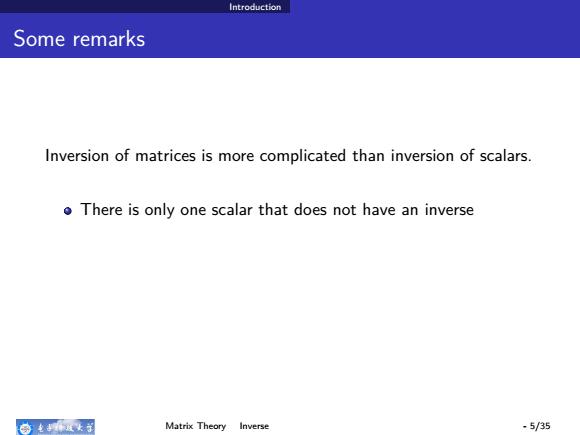
Introduction Some remarks Inversion of matrices is more complicated than inversion of scalars. o There is only one scalar that does not have an inverse 命电有这女 Matrix Theory Inverse -5/35
Introduction Some remarks Inversion of matrices is more complicated than inversion of scalars. There is only one scalar that does not have an inverse : 0. There are many matrices without inverses. How to determine an inverse with respect to matrix multiplication? Matrix Theory Inverse - 5/35